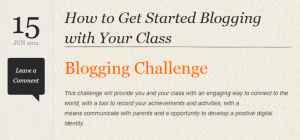Presented at ATLE 2011:
ANYTIME ANYPLACE ANYWARE
Maureen Schlemko @mSchlemko inspireconnections.wordpress.com and Vicky Sahlin @sahlinvic mrssahlin.wordpress.com
“Technology doesn’t improve education – TEACHERS improve education” – Shareski, ATLE 10
Will Richardson: My Kids Are Illiterate. Mostly Likely Yours Are Too
Leadership Matters
Building Teacher Capacity by:
1. Building upon what your school already does
2. Awareness of the leadership & management balance
- Leadership: 0-1 Learning: Roberts, 2001
What relationship/trust building needs to be done for learning to move forward?
Photo posted by badash from yourclimbing.com
- Management: 1-2 Learning
As a leader, what skills to you need?
What structures need to be in place? for classroom/ school/ district/ network?
- Learning: 2-10
Digital Citizenship –
We cannot teach digital citizenship without modeling it.

Blogging with Students
Benefits and Reasons for Blogging with Students
1. Creates a positive digital footprint and provides the opportunity to teach digital citizenship – students today need to understand what affect their digitial footprint has on their life as they grow up and try to enter the work force. Starting at a very young age it is important for us to model, teach and create the opportunity for our students to be building their own postive digital footprint.
2. Communicating with digital tools – helping to build technology skills.
3. Transparency for parents and family – classroom and individual blogging opens the doors to our school, our classrooms and each individuals own learning journey. This mode of communication allows parents to become part of their students learning life, to participate by reading and commenting on their students work. It also opens the doors to the classroom 24/7. It allows parents and students to interact with classroom happenings at a time that works best for them creating a community feel.
4. Provides an authentic audience for student writing – an audience of peers, parents, and a potentially people from all over the world. Allows for multiple feedback loops among the networked students, teachers and other interested parties. Learning in a class blog setting is now a social activity.Students are eager to write for an audience that will be interested and comment on their work. They will also have the urgency to do their best work because it is going to be seen by an audience.
5. Supports differentiation. The blog gives some of our more verbally reserved students a forum for their thoughts. It encourages reading. To make a meaningful comment, or to choose their favorite post, the students first need to read what’s out there. It encourages writing so that your ideas can be read by others. A good blog post can be 3 sentences to 3 pages or anywhere in between, it can include video or pictures to help explain the message, as long as you can make your point your post is effective.
6. Students view of the world changes – we have included a clustr map into the sidebar of our classroomm bolg. This allows us to see where people are visiting from.
Examples of class and individual student blogs.
Classroom Blog – Mrs. Sahlin’s Grade Three Class
Student Blog- http://lifeinspirephotography.wordpress.com/
Student Blog – http://hopeslearningpark.wordpress.com
For example: My 6 year old daughter is in a classroom that has a class blog. One day she comes home and asks me if she can start her own blog. I asked her what she would blog about. She replied with “Things that I learn.” We started her blog after her hounding me for days. He first blog was on ‘Dancing’ which is a passion of hers. She sat down at the computer typed her blog asking how to spell a few words and then told me she was ready for me to read it. We went over it, me reading it aloud to her and her adding a couple of words that she missed. Then we got to have a conversation about capital letters that was not painful in the least becasue she was excited and engages. We went on the web together to find a picture that would be appropriate for her post and we posted her blog. I then used my fantastic Twitter and Facebook connections and asked for #comments for kids. By the next day she had 7 comments on her blog.
What is she learning from this: Positive digital footprint, how to write and comment, appropriate edicate because now she has 7 comments to reply back to and thank them as well as answering their questions, digital citizenship skills, a sense of the global world as one of her comments were from outside of our country and how to use new web tools. I think as a parent and a teacher that this was a pretty good use of a half of an hour of her free time.
How to get Started Blogging
How to Integrate Blogging into your Curriculum





